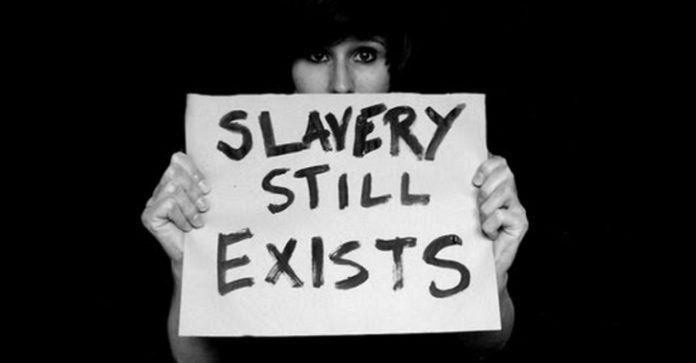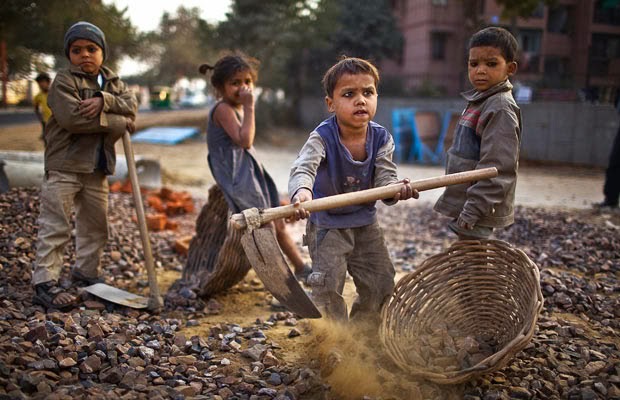
By Carey Wedler at theantimedia.org
Nearly 46 million human beings are subject to slavery, a new report released this week concluded. According to the third annual Global Slavery Index, which gathers and analyzes surveys conducted by Gallup, the number of people forced into “modern slavery,” or “human trafficking, forced labour, debt bondage, forced or servile marriage or commercial sexual exploitation,” rose from 35.8 million to 45.8 million since 2014 — a 28 percent increase.
The Global Slavery Index is a project of Walk Free, an Australian human rights organization dedicated to ending modern slavery, which researchers caution does not mean traditional slavery, in which “people were held in bondage as legal property.”
This year, the researchers for the index analyzed survey responses from 42,000 respondents in 53 languages and 167 countries, though they noted gathering such information is “a difficult undertaking due to the hidden nature of this crime and low levels of victim identification.”
Even so, Andrew Forrest, the founder of Walk Free, suspected the 28 percent increase from 2014 to 2016 was“due to better data collection, although he feared the situation was getting worse with global displacement and migration increasing vulnerability to all forms of slavery,” Reuters reported.
The new analysis highlights the persistence of slavery in modern society, cataloguing the worst-offending nations and noting that instances of modern slavery occurred in all 167 countries included in the study.
According to the report, 58 percent of individuals forced into modern slavery were located in five countries: India, China, Pakistan, Bangladesh, and Uzbekistan. Those nations had the highest “absolute” number of slaves — India was found to have over 18 million slaves, and China, which took second place, had over 3 million.
The report also listed nations with the highest proportions of slaves relative to their total populations: North Korea, Uzbekistan, Cambodia, India, and Qatar.
With over 1.1 million slaves in a nation of just over 25 million, North Korea had the highest proportion of victims, with 4.373 percent of the population subject to servitude. That amounts to roughly 1 in 20 North Korean citizens forced into slavery. As the report explains, in North Korea, “there is pervasive evidence that government-sanctioned forced labour occurs in an extensive system of prison labour camps while North Korean women are subjected to forced marriage and commercial sexual exploitation in China and other neighbouring states.”
The 2016 index further noted other instances of state-sponsored slavery, naming Uzbekistan, Turkmenistan, Tajikistan, Belarus, China, Eritrea, Russia, Swaziland, and Vietnam — as well as North Korea — as the worst offenders.
It also criticized North Korea, Iran, Eritrea, Equatorial Guinea, Hong Kong, Central African Republic, Papua New Guinea, Guinea, the Democratic Republic of the Congo, and South Sudan for their lack of effort in combating slavery.
Interestingly, Iraq, Afghanistan, Yemen, Syria, Somalia, and Libya, all nations subject to U.S. military intervention, tied for sixth place in the list of oppressive countries by proportion to population — totaling several million designated modern slaves among them. But the researchers did not include these nations’ governments when they analyzed efforts to curb slavery, perhaps unintentionally highlighting yet another oppressive force in the contemporary human experience:
“Due to the ongoing conflict and extreme disruption to government function,” they note, “we have not included ratings for Afghanistan, Iraq, Libya, Somalia, Syria or Yemen.”
Critics of the report challenged the statistical methods, arguing the analysts used “flawed methodology by extrapolating on-the-ground surveys in some countries to estimate numbers for other nations.” However, as Reutersreported, “Forrest said a lack of hard data on slavery in the past had held back efforts to tackle this hidden crime and it was important to draw a ‘sand in the line’ measurement to drive action.” He challenged critics to produce an alternative.
“Without measurement you don’t have effective management and there’s no way to lead the world away from slavery,”he said.
Discussing options for eradicating modern slavery, Forrest, an Australian mining billionaire and philanthropist, singled out businesses that fail to scrutinize slavery in the production of their products. “Businesses that don’t actively look for forced labour within their supply chains are standing on a burning platform. Business leaders who refuse to look into the realities of their own supply chains are misguided and irresponsible,” he said. As Reuters noted, the “2016 index again found Asia, which provides low-skilled labor in global supply chains producing clothing, food and technology, accounted for two-thirds of the people in slavery.”
Calling on leaders in government and civil society (as well as business), to work harder in eradicating modern slavery, Forrest ultimately waxed optimistic.
“Through our responsible use of power, strength of conviction, determination and collective will, we all can lead the world to end slavery,” he said.
This article (So, You Thought Slavery Was Dead? Think Again) is free and open source. You have permission to republish this article under a Creative Commons license with attribution to Carey Wedler and theAntiMedia.org. Anti-Media Radioairs weeknights at 11 pm Eastern/8 pm Pacific. If you spot a typo, please email the error and name of the article at[email protected].





I do miss the Netherlands were People are forced to work for their unemployemend for commercial companys underground constant threath and abuse from de “workconsulents”.
China has so many slaves? Are you kidding?